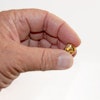
The notion of leaving infected tissue under a restoration goes against the grain for many dentists. But that's exactly what you should be doing for many deep lesions, according to researchers from Federal University of Rio Grande do Sul in Brazil.
“I think in the long term, it's going to be very effective, both for dentists and for patients.”
— Margherita Fontana, D.D.S., Ph.D.
"Many people have the fear of lesion progression beneath the sealing," stated study co-author Marisa Maltz, D.D.S., in an e-mail to DrBicuspid.com. "Some also wonder about the placement of a filling over carious tissue. This resistance is not based in the evidence we have today."
Dr. Maltz presented a study last month at the International Association for Dental Research (IADR) meeting in Miami, suggesting that the survival rate of restorations placed over carious dentin in deep lesions after 10 years is comparable to the survival rates of conventionally restored lesions.
Numerous studies have shown that sealing lesions appears to diminish microbial growth and halt the caries process. And in deep carious lesions, removing carious dentin can also endanger the pulp. The risk that caries will continue if not completely removed has impressed some researchers, while the risk that removing all the dentin will damage the pulp has impressed others, resulting in three different approaches to this type of cavity.
In the traditional approach, the clinician removes all the carious dentin in one procedure. In incomplete dentin caries removal (also known as partial caries removal), some carious dentin remains under the restoration. In the stepwise approach, the clinician excises some of the carious dentin, places a temporary restoration to arrest the caries and give dentin a chance to remineralize, then removes the temporary restoration and finishes removing the still-carious dentin before finally placing a permanent restoration.
The study by Dr. Maltz follows several others (Journal of the American Dental Association, June 2008, Vol. 139:6, pp. 705-712) that found that dentin remineralizes and the caries process stops once the microbes have been sealed away from their nutrient source (sugars in the mouth), lending support to incomplete dentin caries removal.
The study by Dr. Maltz and her colleagues consisted of clinically and radiographically evaluating 32 permanent premolars or molars with deep caries lesions 10 years after incomplete dentin caries removal.
For their study, the researchers included only teeth at risk of pulp exposure, with a lesion depth greater than two-thirds of the dentin thickness. They removed superficial necrotic dentin, leaving layers of soft dentin on the pulp surfaces. But they completely excised decayed tissue from the surrounding cavity walls and protected the pulp with calcium hydroxide cement. Afterward, they sealed the cavities with zinc oxide-eugenol cement and took bitewing radiographs of the affected tooth.
After six to seven months, the researchers opened the cavities and microbiologically sampled the dentin. They found that the dentin had hardened and gotten denser and that the number of bacteria had dropped, suggesting that the caries process was arrested (this preliminary finding was reported in Quintessence International [February 2002, Vol. 33:2, pp. 151-159]). After the sampling, they reapplied calcium hydroxide and placed a more permanent restoration with Charisma resin. After 10 years, 22 patients (26 teeth) remained in the study. Of these, 65.4% (n = 17) of the teeth showed signs of pulp sensitivity, and 34.6% (n = 9) needed root canal therapy. Overall, 81% of the restorations had survived; a rate that compares favorably to the 50% to 78% survival rates of complete conventional caries removal restorations as found in the researchers' review of comparable studies.
The researchers in Dr. Maltz's study did not include a control group because they felt it would be unethical to expose the pulp of any patients with deep carious lesions.
Margherita Fontana, D.D.S., Ph.D., director of the Microbial Caries Research Facility at the Indiana University School of Dentistry, attended Dr. Maltz's presentation and is familiar with the growing body of research on this topic. Dr. Fontana thinks that the incomplete procedure is a good option if the pulp is healthy.
"I think that it's in the patient's best interest to recognize that there's an alternative treatment you can do to buy the tooth years before you think that just putting a crown is your only choice," she said. "We feel there's evidence backing [this] up. Also, the more of these treatments, the more patients you'll be able to see because you'll have simpler treatment that is going to require less chair time. In the long term, it's going to be very effective, both for dentists and for patients."
Copyright © 2009 DrBicuspid.com















